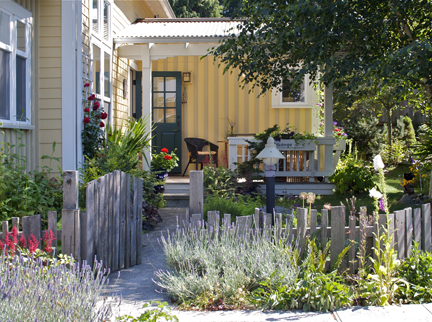This article originally appeared on Pocket Neighborhoods and is reprinted with permission.
Building a community from scratch is daunting, but the good news is that vibrant communities can grow from existing neighborhoods over time through the actions of people who live there, often without much money being spent.
Right here, right now: 10 ways to build community.

1. Move your picnic table to the front yard. See what happens when you eat supper out front. It’s likely you’ll strike up a conversation with a neighbor. Invite them to bring a dish to share. Your kids will probably love it, too.
2. Plant a front yard vegetable garden. Don’t stop with the picnic table. Build a raised bed for veggies; plant edible landscaping and fruit trees. If you’re inclined, invite your neighbors to share your garden. Along with carrots and sweet peas will come conversation and friendship — a bountiful harvest.
3. Build a room-sized front porch. The magic of a good porch comes from the way it is both private and public, belonging to the household while being open to passersby. It may be the most essential element for bringing life to a neighborhood. Its placement, size, relation to the interior and the public space, and height of railings are both an art and a science. First thing to remember: make it more than a tiny cover for fumbling for keys; make it room-sized — a veritable outdoor living room.
4. Add layers of privacy. Curiously, giving your personal space more definition will foster connections with neighbors. A secure space will be more comfortable and more often used, which will increase chances for seeing your neighbors, even if this is a passing nod.
But rather than achieving privacy with a tall fence, consider an approach with layers: a bed of perennial flowers in front of a low fence, with a shade tree to further filter the view. These layers help define personal boundaries, but are permeable at the same time.
Here’s a challenge: can you create six layers between the street and the front door?

5. Take down your backyard fence. Join with your neighbors to create a shared safe play space for children, a community garden, or a wood-fired pizza oven. In Davis, California, a group of neighbors on N Street did just that. Twenty years later, nearly all the neighbors around the block have joined in.
If that’s too radical, consider cutting your six-foot fence to four feet to make chatting across the fence easier, or building a gate between yards.
6. Put up a book-lending cupboard. Take a book, lend a book. Collect your old reads and share them with passersby in a book-lending cupboard mounted next to the sidewalk out front. Give it a roof, a door with glass panes, and paint it to match the flowers below.
Or, change the story: read a poem, write a poem. Create a poetry cupboard with poems to share.
(See Oregon’s City Repair for other inspiring neighborhood-building ideas like this. Check them out!)
7. Organize summer potluck street parties. Claim the street, gather the lawn chairs, and fire up the hibachi! Take over the otherwise “off-limits” street as a space to draw neighbors together.
8. Build resilience together. Create a neighborhood survey of assets, skills, and needs for times of crisis. Frame it around “emergency preparedness,” but watch how it cultivates community.
9. Create an online network for nearby neighbors. Expand the survey into an active online resource and communication tool. Find a new home for an outgrown bike. Ask for help keeping an eye out for a lost dog. Organize a yard sale.
Take advantage of free neighbor-to-neighbor networking tools such as Nextdoor to facilitate communications and build happier, safer neighborhoods. As they say, “online chats lead to more clothesline chats.”

10. Be a good neighbor. It’s easy to focus on your own needs and concerns, but a slight shift in outlook can make a big difference in the day-to-day lives in a neighborhood. Check in on your elderly neighbor if her curtains aren’t raised in the morning. On a hot summer day, put out a pitcher of ice lemonade for passersby, or a bowl of cool water for dogs on walks.
To be sure, grievances among neighbors are common. But when there is a base of goodwill in a neighborhood, little squabbles won’t escalate into turf fights, and neighborhoods can become what they are meant to be — places of support, security and friendship.
##
Ross Chapin is an architect and author of Pocket Neighborhoods: Creating Small-scale Community in a Large-scale World.









